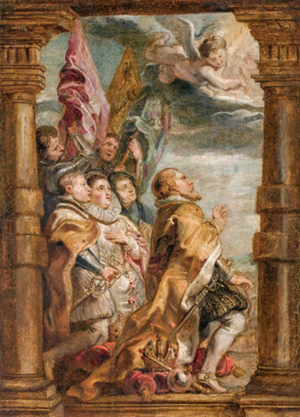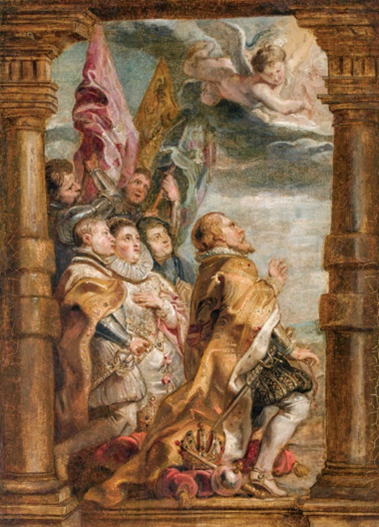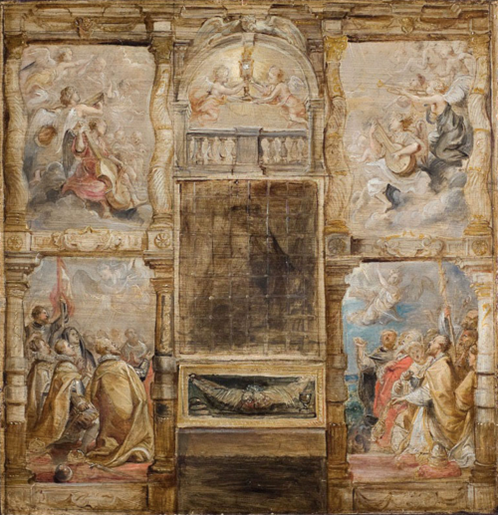
On Monday 14 January, curator and Rubens expert Friso Lammertse of Museum Boijmans van Beuningen presented an oil sketch by Peter Paul Rubens to a panel of fellow experts. The sketch, a design by Rubens for a tapestry, was thought to be lost.
Image: Peter Paul Rubens (1577-1640), The Secular Hierarchy in Adoration, Panel transferred to canvas, 66 x 46 cm c. 1625, Private collection, via Hoogsteder & Hoogsteder
On Monday 14 January, curator and Rubens expert Friso Lammertse of Museum Boijmans van Beuningen presented an oil sketch by Peter Paul Rubens to a panel of fellow experts. The sketch, a design by Rubens for a tapestry, was thought to be lost.
The oil sketch came to the attention of Hoogsteder & Hoogsteder art gallery through an email. The art gallery receives enquiries every day, but this one seemed especially worthy of further examination. Emilie den Tonkelaar, who led the investigation: “There were so many indicators that we were convinced this might very well be a genuine Rubens. The next logical step was to share our findings with Friso Lammertse.” The Museum Boijmans curator and Rubens expert confirmed their conclusions.

Peter Paul Rubens (1577-1640), The Secular Hierarchy in Adoration, Panel transferred to canvas, 66 x 46 cm c. 1625, Private collection, via Hoogsteder & Hoogsteder
Friso Lammertse: “The oil sketches that Rubens made for the Triumph of the Eucharist tapestry series are some of the finest in his oeuvre. It was one of the biggest projects of his career.”
It is extraordinary to be able to add a new discovery to this important series of oil sketches and highly significant for art history.
A genuine Rubens
The painting is an oil sketch made exclusively by Rubens himself. Seventeen of the oil sketches made for the series of twenty tapestries were known. This can now be added as the eighteenth. It is a key part of the series since it depicts four leading figures of early seventeenth-century Europe: kneeling in front is Holy Roman Emperor Ferdinand II (1578-1637). Kneeling behind him are Spain’s King Philip IV (1605-1665), his consort Elizabeth of France (1603-1644) and in cloistral habit, the patron of the series: sovereign of the Netherlands Isabella of Spain (1566-1633).
While part of the painting has been painted over, the detail of the style and palette are recognisably Rubens. The dimensions are also equivalent to those of other oil sketches in the series. Conclusive proof came with the infrared photo commissioned by the owner. This shows that the title of the work is written in the ground below the surface paint, as is also the case in some of the other oil sketches in the series. Moreover, the photo reveals that the painting was originally made on panel, like the other oil sketches. It was only later transferred to canvas.
Emilie den Tonkelaar: “We knew that Rubens would have made the oil sketch around 1625. Everyone thought the work had been lost. We had no picture of it either. That we now have the sketch again after over 350 years is amazing.”
Oil sketch for Triumph of the Eucharist tapestry series
This is an oil sketch for the Triumph of the Eucharist series of twenty tapestries. Isabella of Spain, sovereign of the Netherlands, had commissioned Rubens to design the series for Madrid’s Monesterio de las Descalzas Reales. This was one of the biggest projects of his career. The oil sketches, all of which he painted himself, are among the finest of his oeuvre.
The tapestries have been preserved and can still be viewed at the monastery. Many of the designs Rubens made for the series also survive. Rubens began by painting small studies (c. 16 cm in height). Around eleven of these remain. He then made the wonderful large, colourful oil sketches, of which seventeen were known; this new discovery is the eighteenth.
Rubens left the creation of the large cartoons on which the weavers based their designs when weaving the tapestries to his assistants.
Depicted characters
Kneeling in front is Holy Roman Emperor Ferdinand II (1578-1637). He was the principal temporal ruler in Christendom. Beside him on a cushion are his crown, sceptre and orb. Ferdinand II was a brother-in-law to Philip III. Philip III was married to Ferdinand’s sister. Philip III had already died by the time this tapestry was woven. His son Philip IV, nephew to Ferdinand II, was his successor.
King Philip IV (1605-1665) appears in the left of the painting, with his crown beside him on a cushion. Seated next to him is his consort Elizabeth of France (Elizabeth Isabella of Bourbon of France, 1603-1644).
The woman in the cloistral habit appears to be Isabella of Spain (1566-1633). She was sovereign of the Netherlands and a half-sister of Philip III. It was she who commissioned this highly significant series of tapestries, which she intended for the cloister to which she planned to retreat. She had taken to wearing the habit after the death of her husband Albert in 1621. The tapestries can still be seen in that religious house of Descalzas Reales.

Adoration of the Eucharist, Panel, 31.5 x 32 cm, Art Institute of Chicago, 1937.1012
This is a combination of the original small studies Rubens made for the tapestries on a single panel. It was the beginning of the design process, after which Rubens made the oil sketches, including the new discovery.
Top left and right show angels playing music. Top centre: two putti present the monstrance with the sacred host. Below right: The Ecclesiastical Hierarchy in Adoration (oil sketches at Speed Museum of Art, Kentucky). Below left: The Secular Hierarchy in Adoration, of which the original oil sketch has now been found by Hoogsteder & Hoogsteder.

ArtDependence Magazine is an international magazine covering all spheres of contemporary art, as well as modern and classical art.
ArtDependence features the latest art news, highlighting interviews with today’s most influential artists, galleries, curators, collectors, fair directors and individuals at the axis of the arts.
The magazine also covers series of articles and reviews on critical art events, new publications and other foremost happenings in the art world.
If you would like to submit events or editorial content to ArtDependence Magazine, please feel free to reach the magazine via the contact page.